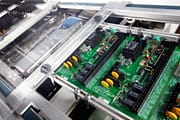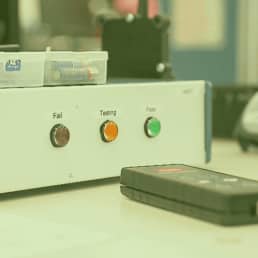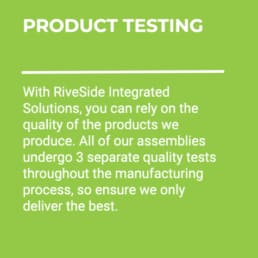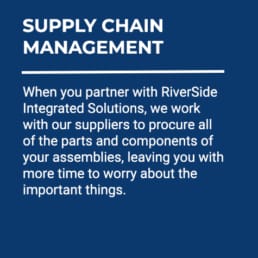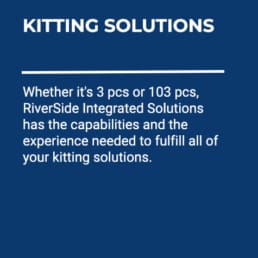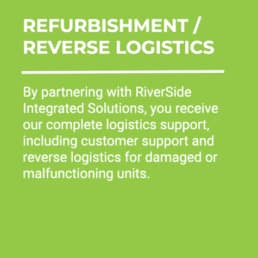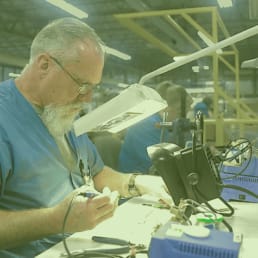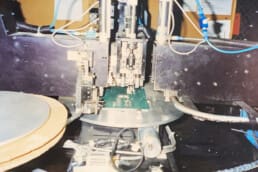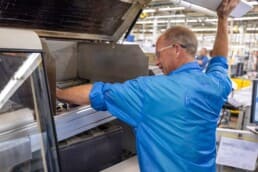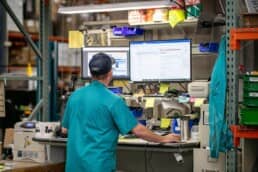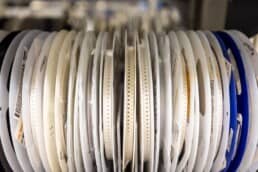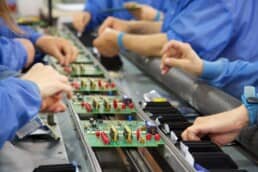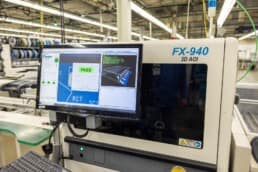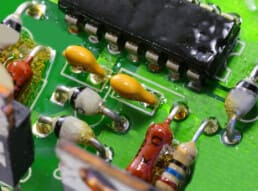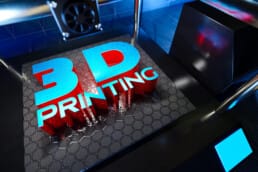Soldering is a crucial step in the printed circuit board assembly (PCBA) process. It uses molten solder to bond the various components to the board. Solder is an alloy typically composed of a combination of elements. One of the most common for printed circuit boards (PCBs) is lead-free (Sn-Cu) rosin core solder. Still, there are many varieties of solder available. The other essential ingredient in soldering is flux.
PCBA uses three primary soldering techniques: wave, reflow and selective soldering.
Original equipment manufacturers (OEMs) need to be careful to decide which soldering technique is best for their assembly. That’s just one reason they need to partner with a trusted contract manufacturer like RiverSide Integrated Solutions (RIS). Our team at RIS guides customers through this process. We help you choose the right PCBA technologies and techniques for your specific needs.
Before diving further into the details of soldering techniques, let’s review the steps involved in PCBA. This can help you better understand the role of soldering and where it fits in the process.
AN OVERVIEW OF THE PCBA PROCESS
Below are the primary steps in the PCBA process. The steps and sequencing may vary slightly depending on the type of technology used. However, the following describes the key elements of any PCBA process.
1. APPLY SOLDER PASTE
The first step is to apply the solder paste where components will be mounted. The paste is a mixture of solder and flux used to permanently join the components to the board.
At RIS, we use a stencil to guide the solder paste. This ensures it is delivered to the correct areas of the board and in the proper amount.
2. PLACE THE COMPONENTS
The next phase is to place the necessary components on top of the solder paste. This step is often called “pick-and-place”. There are many different types of components depending on a PCB’s functionality. Some of the most common are resistors, capacitors, inductors, sensors or other electrical parts.
Placement can be performed manually or with automation. Either way, the correct components must be placed in the specified location on the board.
3. SOLDERING
The purpose of this step is to permanently bond the components to the PCB. Surface mount technology (SMT) PCBA processes typically utilize a reflow oven or selective solder machine. These may be combined with a conveyor system during the soldering stage.
With through-hole technology (THT), the components have leads that go through existing holes on the board. A wave soldering method is the most common way to solder these boards. A wave solder machine uses a wave of molten solder that flows across the bottom of the board.
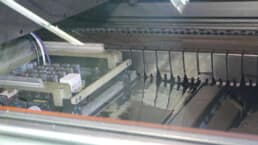
In both cases, the molten solder joins the components and leads to the board. More importantly, it does so without compromising performance or structural integrity. The assembly is then cooled to solidify the solder once again and fix the parts in place.
4. INSPECT THE ASSEMBLY
This phase of the PCBA process is crucial. Proper inspection is necessary to ensure production staff and machines performed prior steps effectively. This step may entail both manual, automatic and x-ray technology.
5. TESTING
The final step in the PCBA process is testing to ensure the PCB functions as designed. There are various test methods, such as flying probes, in-circuit testing, and others. The PCBA process is complete once testing is done.
PRIMARY PCBA SOLDERING TECHNIQUES: REFLOW AND WAVE
As mentioned above, reflow, selective and wave soldering are the main soldering techniques used during automated PCBA processes. The best soldering method for a given application often depends on the type of PCB components.
Wave soldering is often utilized for a board with mostly through-hole components. On the other hand, boards with SMT components usually use reflow or selective soldering. At RIS, we utilize selective solder machines for our SMT based assemblies.
Below is more information about each method.
WAVE SOLDERING
With this method, the board is sprayed with flux and then routed through a wave of molten solder. Sometimes, the PCB goes through multiple waves of solder. A pump submerged in the molten solder makes a standing wave for the board to pass through. As the molten solder cools, it hardens and connects the components to the board.
Although both THT and SMT assemblies can utilize wave soldering, it is more common for THT boards. This is because the solder will fill the through-hole component vias more adequately, making a better connection.
In recent years, SMT has largely replaced THT. Thus, the demand for wave soldering has declined. However, there is still significant wave soldering where THT is prevalent or SMT is unsuitable.
REFLOW SOLDERING
In reflow soldering, solder paste, a sticky mixture of powdered solder and flux, is applied to the PCB. This bonds components to their contact pads on the board temporarily. When the assembly is heated, the solder melts to a molten state.
The heating typically occurs by passing the board through an industrial convection oven. Upon cooling, the solder hardens to permanently bond the components to the board. At the same time, this forms the electrical connections for the assembly. Double-sided boards are sent through the reflow oven twice, once for each side.
During reflow soldering, the paste must reach the eutectic temperature. This is the temperature at which the specific solder alloy melts to a molten state. Designers carefully calculate the temperature profile for a given PCBA to achieve the optimal temperature. They must ensure that the solder reflows without overheating and damaging the electrical components.
Reflow soldering is primarily used for boards with SMT components, but may also be utilized for THT component. In this case, it fills the holes that the components sit through with paste.
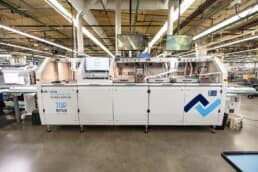
SELECTIVE SOLDERING
Selective soldering is a specialized soldering technique primarily used for assemblies with a mix of SMT and THT. Unlike wave and reflow soldering, selective soldering precisely targets and solders specific areas on the PCB.
In selective soldering, the machine equips solder nozzles that deliver molten solder to the joints that require soldering. This precise control allows for the soldering of components and other areas that may not be suitable for reflow.
Selective soldering offers several advantages. It reduces heat exposure to sensitive components, offers better control and gives the ability to handle complex designs. It is especially useful when transitioning from traditional THT to SMT components in a single assembly.
At RIS, our utilization of selective solder machines for assemblies ensures the highest quality and reliability for our PCBAs. This is true even when dealing with a diverse range of component types!
Selective solder machines also produce a fraction of the waste produced by other machines. Using these machines for our assemblies has allowed us to considerably reduce the waste our soldering process produces.
RIS PCBA EXPERTISE
At RIS, PCB assembly is one of our core competencies. We provide reliable, seamlessly-assembled printed circuit board systems built with extreme precision.
Our skilled engineers, technicians and assemblers work to expertly put together a complete PCBA. When you choose RIS, you can expect the hands-on customer care of a small operation with the capabilities characteristic of a larger company. We provide our complete electronics manufacturing services for OEMs in any industry.
Our electronics assembly expertise includes:
- Surface Mount Technology (Fine-pitch, BGA (1 mm), µBGA (.4 mm), 01005, X-Ray, automated rework, and automated optical inspection (AOI)
- Magazine to Magazine handling
- Smart Shelving floor stock inventory control
- X-ray reel counting
- Lead-through auto-insertion (Axial, Radial, DIP, and Zierick Terminals)
- Wave Solder and Selective Solder Machines (No-clean & aqueous flux processes) RoHS and Tin/Lead capabilities
- Special Application Equipment (Cobot dispensing systems)
- Conformal coating (Silicone, Urethane)
- Potting (Epoxy, Urethane, and Silicone)
- Low-pressure molding technology
- Comprehensive product testing
- 3D Printing
About RiverSide Integrated Solutions
RIS is an advanced contract manufacturer providing robust solutions in circuit board assembly and product assembly. We employ more than 350 people and provide services to OEMs worldwide. We operate two state-of-the-art manufacturing facilities within the US.
With all of the choices in contract manufacturers out there, we know it can be challenging to find someone who understands your business model and has your best intentions in mind. RIS has always proven to be a win-win-focused relationship.
As your one-stop shop, we have the capabilities, capacity, quality assurance standards and resources to support all of your manufacturing needs. We understand that supply chain management is complex and very time-consuming, so we urge our customers to utilize us in the fullest capacity.
Our total-package solutions include:
- Extensive supply-chain network
- Full box-build assembly
- Dedicated Program Team
- Warehousing, kitting and drop-shipping capabilities
- Reverse logistics
- Flexible order fulfillment
- Scalability to meet your needs
Contact us today at (507) 523-3220 to see how we can help with your manufacturing project, or click contact us for a quote.
